|
|
|
Sort Order |
|
|
|
Items / Page
|
|
|
|
|
|
|
| Srl | Item |
| 1 |
ID:
164604
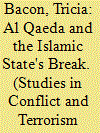

|
|
|
|
|
| Summary/Abstract |
Employing counterfactuals to assess individual and systemic explanations for the split between Al Qaeda and the Islamic State of Iraq and al-Sham (ISIS), this article concludes that individual leaders factor greatly into terrorist alliance outcomes. Osama bin Laden was instrumental in keeping Al Qaeda and ISIS allied as he prioritized unity and handled internal disputes more deftly than his successor, Dr. Ayman al-Zawahiri. Although a troubled alliance, strategic differences between Al Qaeda and ISIS were not sufficient to cause the split. Rather, the capabilities of Al Qaeda's leader determined the group's ability to prevent alliance ruptures.
|
|
|
|
|
|
|
|
|
|
|
|
|
|
|
|
| 2 |
ID:
164605
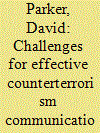

|
|
|
|
|
| Summary/Abstract |
Growing concerns about small-scale, low sophistication terrorist attacks, and the difficulties they present for security services, make public coproduction of security increasingly necessary. Communication to ensure that the public(s) is aware of the role they can play will be central to this. This article, based on interviews with thirty expert practitioners, explores challenges associated with communication designed to prevent radicalization, interdict attack planning and mitigate the impacts of a terrorist attack in the United Kingdom and Denmark. The interplay between these challenges and the contemporary terrorist context are analyzed, highlighting that new, or adapted, communications and approaches may be necessary.
|
|
|
|
|
|
|
|
|
|
|
|
|
|
|
|
| 3 |
ID:
164595


|
|
|
|
|
| Summary/Abstract |
Social media offer unprecedented opportunities to terrorist groups to spread their message and target specific audiences for indoctrination and recruitment. In 2013 and 2014, social media, in particular Twitter, overtook Internet forums as preferred space for jihadist propaganda. This article looks into Arabic statements by Jabhat al-Nusra, Islamic State and jihadist forum administrators and online activists to argue that, beside the easier use of social media and disruption and infiltration of the forums, the conflict between the jihadist groups accelerated the migration to social media and the building of a presence on Twitter that provided relative resilience to suspensions.
|
|
|
|
|
|
|
|
|
|
|
|
|
|
|
|
| 4 |
ID:
164596


|
|
|
|
|
| Summary/Abstract |
This article examines how the United Patriots Front (UPF), an Australian far-right organization, has communicated its ideology with reference to right-wing politics in Australia, Western Europe, and the United States, and through allusions to Islamic State. The investigation uses critical discourse and documentary analysis and a framework derived from the theory of Pierre Bourdieu to analyze textual and audiovisual postings on UPF Facebook pages, YouTube channels, and Twitter accounts. Relevant to the discussion are Bourdieu’s interdependent theories on “doxa” as a condition in which socially constructed phenomena appear self-evident, and “habitus” and “field,” which explain how structures and agents, through their reflexive behavior, become dialectically situated.
|
|
|
|
|
|
|
|
|
|
|
|
|
|
|
|
| 5 |
ID:
164606
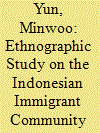

|
|
|
|
|
| Summary/Abstract |
Contrary to popular belief, South Korea is not immune from the growth of Islamic radicalism. Although no serious terrorist attack has yet occurred within the country, some worrisome incidents have been reported. Recently, an Indonesian man was arrested on the grounds that he publicly supported the Al Nusra Front, a known Al Qaeda–affiliated terrorist organization, and even attempted to depart for Syria to join the organization. The current study is a response to such an incident. It investigates whether such an incident is an isolated exception or a harbinger of the Islamic radicalization process within South Korea, particularly within the Muslim immigrant community. The current study focuses primarily on the Indonesian immigrant community within South Korea but also investigates other Muslim communities when needed, as Muslim immigrant communities are often intermingled and share similar features. The study found some worrisome developments of Islamic radicalization within the Indonesian immigrant community in particular and the Muslim immigrant community in general. Using the enculturation stress model, the current study explains that such Islamic radicalization is a pathway of the collective response to cultural adaptation stress that most Indonesian and other Muslim immigrants face within South Korea. To conduct the study, ethnographic qualitative interviews were used. Indonesian immigrants, their Korean spouses, civilian activists, civilian aid workers, government officials, police officers, immigrant agency officials, and security officials were contacted and interviewed. Each interview lasted between approximately one and four hours. The limitations of the study are also discussed.
|
|
|
|
|
|
|
|
|
|
|
|
|
|
|
|
| 6 |
ID:
164597


|
|
|
|
|
| Summary/Abstract |
This article offers a method for systematically grading the quality of Islamic State of Iraq and Syria (ISIS) videos based on technical production criteria. Using this method revealed moments when ISIS production capacity was severely debilitated (Fall 2015) and when they began to rebuild (Spring 2016), which the article details. Uses for this method include evaluating propaganda video output across time and across groups, and the ability to assess kinetic actions against propaganda organizations. This capacity will be critical as Islamic State media production teams will be pushed out of its territory as the State collapses.
|
|
|
|
|
|
|
|
|
|
|
|
|
|
|
|
| 7 |
ID:
164601


|
|
|
|
|
| Summary/Abstract |
Online countermessaging—communication that seeks to disrupt the online content disseminated by extremist groups and individuals—is a core component of contemporary counterterrorism strategies. Countermessaging has been heavily criticized, not least on the grounds of effectiveness. Whereas current debates are focused on the role of government and large organizations in developing and disseminating countermessages, this article argues that such approaches overlook the informal production of countermessages. Recognizing the appetite for “natural world” content among those engaged in countermessaging, this article highlights some of the potential benefits of informal approaches to countermessaging. At the same time, the article also acknowledges the risks that may result from closer working between countermessaging organizations and informal actors.
|
|
|
|
|
|
|
|
|
|
|
|
|
|
|
|
| 8 |
ID:
164593


|
|
|
| 9 |
ID:
164599


|
|
|
|
|
| Summary/Abstract |
This article reports and discusses the results of a study that investigated photographic images of children in five online terrorist magazines to understand the roles of children in these groups. The analysis encompasses issues of Inspire, Dabiq, Jihad Recollections (JR), Azan, and Gaidi Mtanni (GM) from 2009 to 2016. The total number of images was ninety-four. A news value framework was applied that systematically investigated what values the images held that resulted in them being “newsworthy” enough to be published. This article discusses the key findings, which were that Dabiq distinguished different roles for boys and girls, portrayed fierce and prestigious boy child perpetrators, and children flourishing under the caliphate; Inspire and Azan focused on portraying children as victims of Western-backed warfare; GM portrayed children supporting the cause peacefully; and JR contained no re-occurring findings.
|
|
|
|
|
|
|
|
|
|
|
|
|
|
|
|
| 10 |
ID:
164594
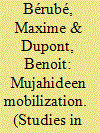

|
|
|
|
|
| Summary/Abstract |
Drawing on Tilly’s notion of “repertoire of action,” this article shows how the evolution of the global jihadist movement’s communicative action repertoire has increased the potential resonance of its discourse. It foresees the construction of the global jihadist movement’s discourse of mobilization as the result of the evolution of its network of actors, the context in which its communications are undertaken, and its adaptation to new communication technologies. Accordingly, it argues that the decentralization of the global jihadist movement has led to a widening of its communicative action repertoire and a diversification of its discourse offering.
|
|
|
|
|
|
|
|
|
|
|
|
|
|
|
|
| 11 |
ID:
164602


|
|
|
|
|
| Summary/Abstract |
The proliferation of social media has created a terrorist finance vulnerability due to the ease with which propaganda can be spread, promoting fund-raising for a certain cause. Social media companies recognize the importance of preventing violent extremist and terrorist content, but less attention is paid to their fund-raising role. As well as presenting a threat, the movement of terrorist fund-raising activities online creates a disruption opportunity. This article argues that social media companies need to display greater awareness of their vulnerability to supporting terrorist financing and greater collaboration with law enforcement and financial institutions to strengthen the integrity of the system against abuse.
|
|
|
|
|
|
|
|
|
|
|
|
|
|
|
|
| 12 |
ID:
164603
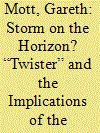

|
|
|
|
|
| Summary/Abstract |
“Twister,” developed by Miguel Freitas, is a social network platform centered around micro-blogging, much like Twitter. However, rather than relying on centralized servers owned and maintained by a single firm, Twister users operate a blockchain combined with distributed hash table (DHT)–like and BitTorrent-like protocols to both make posts and send private messages, and also to receive entries from other users. Twister’s raison d’etre is that it offers a social networking platform that cannot be censored and cannot itself censor. The software does not record the Internet Protocol addresses users use to access the service, nor does it notify other users of an account’s online/offline status. Growing adoption of blockchain services means that it is possible that the concept of decentralized social networks could become a norm. It is suggested in this article that blockchain-based peer-to-peer social networks present challenges to the current counterextremist practices for content removal and censorship. While there are methods to disrupt usage of blockchain-based peer-to-peer services, these approaches may have the net harm of curtailing bona fide use of legal and novel technologies. Given this opportunity cost, non-transitory online violent extremist content may need to be tolerated.
|
|
|
|
|
|
|
|
|
|
|
|
|
|
|
|
| 13 |
ID:
164598
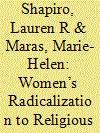

|
|
|
|
|
| Summary/Abstract |
American women joining Islamic State of Iraq and Syria (ISIS) have increased and their roles evolved beyond auxiliary and domestic provisions, demonstrating both agency and tenacity for pursuing, recruiting, supporting, and spreading extreme Islamist ideals and terrorism. Social learning theory was applied to information gained from open-source court cases as a way of examining how thirty-one U.S. women acquired, maintained, and acted pursuant to radicalization to religious terrorism for ISIS. Internet functionalities, reasons, roles, and support types for radicalization and illegal activities for ISIS were examined using self-, dyad-, and group-classifications. A gendered interventive program based on social learning theory’s extinguishing of radicalized ideology and behavior was outlined.
|
|
|
|
|
|
|
|
|
|
|
|
|
|
|
|
|
|
|
|
|